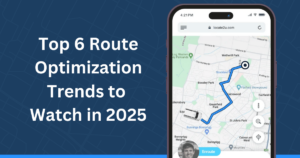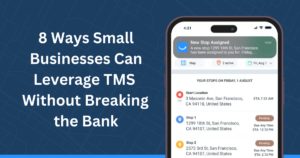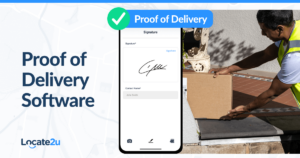
Enhancing performance with route planning and optimization are essential factors in ensuring efficient and cost-effective delivery processes. In today’s competitive business environment, organizations recognize the significance of strategically selecting the most optimal routes for delivering goods and services. By considering factors such as distance, traffic conditions, and delivery time windows, route planning, and optimization aim to minimize travel time, fuel consumption, and operational expenses.
With advanced software solutions, organizations can streamline their delivery operations, improve resource utilization, and provide a seamless customer experience. Throughout this article, we will explore the importance and benefits of route planning and optimization in enhancing operational performance.
Enhancing Performance with Route Planning and Optimization Guide

Route planning and optimization expertise
The purpose of route planning and its goals
Route planning is the process of determining the most practical and effective way to travel to a destination or group of locations. It involves determining the optimal routes to take to reduce travel time, cost, and distance as well as selecting the best stops to make in the appropriate order. Route planning tries to streamline logistics and transportation operations by maximizing the flow of goods, services, or people.
Vital Components of Route Optimization
Route optimization employs advanced approaches and algorithms to identify the most effective transportation routes. It considers a number of factors in order to boost productivity and efficiency. Essential components of route optimization include:
- Geographic Information System (GIS): Using GIS technology, geographic data may be mapped and analyzed to provide precise route planning. It offers details on traffic patterns, road networks, and other pertinent spatial data.
- Real-Time Data Integration: Dynamic route changes are made possible by incorporating real-time data sources such as traffic updates, weather reports, and vehicle tracking data. This guarantees flexibility in response to shifting conditions and improves route optimization.
- Vehicle Capacity and Limitations: By taking into account factors like maximum load capacity, vehicle dimensions, and weight constraints, routes can be more effectively planned. It guarantees that the designated vehicles are appropriate for the particular needs of each stop.
- Time Windows and Delivery Priorities: Priorities for delivery and time windows are taken into account during route optimization. It takes into account restrictions such as set delivery windows, client preferences, and service level agreements to ensure prompt and effective operations.
- Multiple Restrictions: Route planning and optimization that is effective take numerous limitations into account at once. These could, among other things, take the form of traffic limitations, fuel prices, and driver work hours. Finding the best paths is made easier by balancing these restrictions.
Benefits of Route Planning and Optimization Success
Organizations engaged in logistics and transportation can get a number of advantages from effective route design and optimization, including:
- Cost reduction: By optimizing routes, businesses can save back on labor costs as well as fuel and vehicle wear and tear. Reduced mileage and idle time as a result of efficient routing result in significant cost savings.
- Enhanced Efficiency: Time savings and higher production result from making sure that vehicles take the shortest and most feasible routes. It provides for the best possible resource utilization by getting rid of inefficient routes, cutting down on pointless detours, etc.
- Improved Customer Service: Route planning and optimization help to increase customer satisfaction by delivering goods and services in a timely and dependable manner. The total customer experience is improved by accurate arrival time predictions, greater communication, and effective order fulfillment.
- Lessening the impact on the environment: Optimized routes reduce fuel use and vehicle emissions, promoting environmental sustainability. Organizations can actively contribute to environmental conservation initiatives by lowering unnecessary miles flown.
- Improved Resource Utilization: Route optimization makes sure that resources, such as cars, and drivers, are used as efficiently as possible. It facilitates effective resource allocation, and workload balance, and prevents resource overuse or underuse.
- Enhanced Safety: Considerations including traffic conditions, road limits, and hazardous regions are taken into account while selecting an effective route. Organizations can increase driver and freight safety by avoiding high-risk areas and taking safety standards into account.

Enhancing Efficiency with Route Planning
The Value of Exact Data Gathering and Analysis
Effective route planning is built on accurate data collection and analysis. It entails compiling pertinent data regarding clients, delivery locations, traffic patterns, tripping hazards, and other aspects that influence logistics operations. Organizations can learn more about past performance, demand trends, and prospective improvement areas by gathering and evaluating data. To increase overall efficiency, accurate data is essential for locating bottlenecks, streamlining routes, and making wise judgments.
Making Use of Tools and Technology for Efficient Route Planning
In order to plan and optimize routes, technology is essential. Organizations can make judgments based on data thanks to modern software, GPS systems, and route optimization technologies. Organizations may effectively evaluate massive volumes of data, create optimized routes, and spot real-time changes to react to dynamic conditions by utilizing technology. Additionally, tools like geographic information systems (GIS) provide accurate route planning assistance by providing detailed maps and traffic data.
Techniques for Cutting Fuel Consumption and Costs
Transportation operations may be greatly impacted by fuel prices. Planning your journey wisely can cut expenditures and fuel use. Techniques for doing this include:
Efficient Routing
By identifying the shortest, best routes, businesses can cut down on wasteful mileage and idle time. Fuel can be saved by avoiding congested regions, traveling on busy roads, and taking into account things like road conditions and posted speed limits.
Load Optimization
Optimum load capacity utilization is ensured by properly assigning and arranging goods in trucks. Organizations can limit the number of trips necessary and hence lower fuel usage by optimizing load distribution.
Maintenance and Optimization of Cars
Maintaining and monitoring cars on a regular basis helps them run more efficiently. Tires that are properly inflated, engine tune-ups, and strategic vehicle routing can enhance fuel efficiency and lower operating expenses.
Driver Training and Behaviour
Teaching drivers how to drive more fuel-efficiently, such as avoiding abrupt acceleration or braking, maintaining constant speeds, and cutting down on idle time, can have a big impact on fuel usage.
Improving Customer Satisfaction and On-Time Delivery
A key element in ensuring client loyalty and happiness is on-time delivery. Effective route planning is essential to improving on-time delivery since it:
- Accurate Time Window Management: Route design takes pickup and delivery time windows into account. Organizations can achieve delivery deadlines and improve customer satisfaction by planning routes that take into account consumer preferences and expectations.
- Real-time updates and communication: By using real-time data and communication technologies, firms may respond quickly to changing conditions and give customers up-to-date information. This proactive approach aids in managing client expectations and upholding openness.
- Effective order fulfillment: Organizations can effectively complete client orders thanks to route optimization and streamlined logistics procedures. Organizations may increase customer happiness and establish confidence by shortening delivery times, minimizing errors, and improving order accuracy.
- Customer-Focused Routing: Personalized service is ensured by tailoring routes depending on customer preferences and service level agreements. Organizations can optimize routes for greater customer satisfaction by taking into account variables including desired delivery times, special requirements, and consumer location.
Route Optimization for Productivity
Finding bottlenecks and enhancing delivery schedules
Identifying bottlenecks and streamlining delivery schedules are important steps in route optimization for productivity. Organizations can spot locations with delays or inefficiencies by looking at historical data. This may include congested routes, busy times, or particular delivery spots that frequently encounter difficulties. Organizations can modify delivery schedules, deploy more personnel if necessary, and optimize routes to reduce delays and boost overall efficiency by recognizing these obstacles.
Using Real-Time Data to Adjust Routes Dynamically
Real-time data is essential for maximizing the productivity of routes. Organizations can modify routes dynamically by combining real-time information on traffic patterns, road closures, and weather updates. As a result, they can quickly avoid delays, identify alternate routes, and optimize delivery routes. Real-time data integration enables businesses to quickly adapt to changing conditions, resulting in effective and profitable transportation operations.
Using Predictive Analytics to Plan Proactive Routes
An effective tool for proactive route planning is predictive analytics. Organizations can use predictive models to foresee future demand, traffic patterns, and potential disruptions by evaluating historical and real-time data. This makes it possible to plan routes in advance by figuring out the best ones based on what to expect. Additionally, predictive analytics supports effective route routing, resource forecasting, and load distribution optimization. Organizations may make wise judgments and improve routes to increase productivity by utilizing data-driven insights.
Managing Workload and Using Resources to the Fullest
It involves balancing workload and maximizing resource use to optimize pathways for productivity. This includes distributing vehicles, drivers, and other resources effectively. Organizations can design routes to make sure that resources are used as efficiently as possible by taking into account variables like vehicle capacity, driver availability, and workload distribution. In addition to preventing overloading or underutilizing resources, workload balancing helps firms achieve delivery deadlines, cut down on idle time, and boost productivity in general.
Organizations can also use technology and tools to help balance their workloads. When allocating deliveries, route optimization software can examine numerous aspects and restrictions, taking into account things like delivery time windows, vehicle capacity, and driver availability. By doing this, it is made possible to deploy resources as efficiently as possible, balance routes, and increase production.

Improving Compliance and Safety
When planning a route, take safety regulations and restrictions into account
Consideration and adherence to safety laws and constraints are necessary to improve safety and compliance in route planning. When determining routes, organizations must consider things like weight restrictions, height restrictions, road closures, and hazardous regions. Organizations can reduce the risk of accidents and noncompliance with regulatory requirements by including these regulations in the route design process and ensuring that vehicles follow safe and legal courses.
Reducing Risks Through Driver Training and Optimised Routes
Optimized routes reduce risks and eliminate potential dangers, which increases safety. Organizations can avoid high-risk areas, difficult driving conditions, and accident-prone areas by carefully arranging their routes. Additionally, increasing safety during transportation operations involves training drivers in safe driving habits, defensive driving strategies, and adherence to traffic laws. Drivers who receive adequate training are better prepared to deal with a variety of roadside scenarios, which lowers the risk of accidents and increases overall safety.
Including Real-Time Weather and Traffic Updates for Safer Travel
For safer travel, real-time traffic and weather updates are essential. Organizations can plan routes in an informed manner and change them as necessary by incorporating these updates. Real-time traffic information enables route changes to minimize delays and potential dangers by identifying crowded regions, accidents, or road closures. In the same manner, taking weather predictions and circumstances into account aids in choosing safer routes and assuring the security of the driver and cargo. Organizations can proactively reduce hazards and improve safety during transportation operations by monitoring traffic and weather conditions.

Using Technology to Improve Performance
The importance of GPS and telematics for route planning and optimization
Route planning and optimization heavily rely on the Global Positioning System (GPS) and telematics. Organizations can precisely track and track the movements of cars thanks to the real-time position information that GPS gives. Telematics systems offer complete vehicle data, such as speed, fuel usage, and engine diagnostics, by fusing GPS technology with onboard sensors and communication tools.
In route planning, GPS and telematics enable organizations to:
- Accurately Determine Vehicle Location: GPS delivers exact location data, enabling enterprises to monitor cars in real-time and precisely track their whereabouts during route planning. Route planning and optimization are made possible with the help of this information.
- Monitor Vehicle Performance: Telematics systems gather and examine information on a range of vehicle characteristics, including fuel usage, engine output, and driver behavior. By using this information, routes can be improved where necessary.
- Enable dynamic route adjustments: Thanks to real-time GPS and telematics data, organizations can change routes dynamically in response to factors like traffic conditions, road closures, or unforeseen events. This ensures that routes are kept optimized and that vehicles can travel the most efficient paths.
- Improve Fleet Management: By incorporating GPS and telematics into route planning, businesses can enhance their fleet management capabilities. They can monitor how the vehicles are utilized, plan for preventive maintenance, cut down on fuel use, and ensure that rules are being adhered to.
The Advantages of Automation and AI for Route Optimization
By utilizing cutting-edge algorithms and data analysis, automation and artificial intelligence (AI) significantly improve route optimization. Some major advantages include:
- Enhanced Accuracy and Efficiency: AI and automation algorithms can accurately and quickly process enormous volumes of data. They are able to determine the best routes with accuracy and efficiency by analyzing a variety of variables, including customer locations, delivery time windows, traffic patterns, and historical data.
- Real-Time Decision-Making: AI-based systems are capable of incorporating real-time data sources, such as traffic updates or weather reports, to alter routes dynamically. This enables businesses to adjust to changing conditions and optimize routes as they go for optimal effectiveness.
- Cost optimization: Algorithms driven by automation and AI for route optimization take into account a variety of costs, including fuel usage, vehicle capacity, driver hours, and maintenance costs. Organizations can lower operating expenses and boost overall profitability by optimizing routes based on these variables.
- Scalability and Adaptability: AI and automation technologies are scalable to support big fleets or high-volume operations and can manage complex routing scenarios. They are capable of adapting to shifting business demands and streamlining routes to effectively fulfill changing requirements.
- Increased Customer Satisfaction: Optimised routes lead to quicker delivery, precise arrival time predictions, and improved service in general. Organizations may improve customer satisfaction, boost on-time delivery, and enhance the overall customer experience by utilizing automation and AI in route planning.

Measurement of Performance and Ongoing Improvement
Key Performance Indicators for Route Planning and Optimization (KPIs)
Finding and monitoring key performance indicators (KPIs) that indicate the effectiveness and efficiency of the logistics operations is necessary for measuring performance in route planning and optimization. Several pertinent KPIs include:
- On-time Delivery: This KPI calculates the proportion of deliveries that occur inside the predetermined window of time or pre-arranged delivery time. It demonstrates the capacity to fulfill client expectations and guarantees prompt service.
- Roadway Effectiveness: Route optimization is assessed using route efficiency KPIs, which take into account variables including mileage, idle time, and the number of stops. These KPIs aid in evaluating how well route planning reduces wasteful travel and makes the best use of available resources.
- Fuel Consumption: Tracking fuel usage can give you information about how well routes work and how well cars are operating. The average fuel consumption per mile or trip, changes in fuel efficiency over time, and comparisons to benchmarks or industry norms are among the KPIs in this area.
- Cost per Delivery: This KPI calculates the expenses related to each delivery, including those related to labor, maintenance, and overhead. Monitoring the cost per delivery can assist find opportunities for cost- and efficiency-saving measures.
Tracking and Assessing Performance Indicators
Organizations must set up procedures for tracking and assessing performance indicators if they want to measure performance effectively. This entails:
- Data collection and analysis: It’s crucial to gather pertinent information on delivery times, fuel usage, expenses, and other performance-related indicators. Accurately gathering and evaluating this data depends on automated systems, GPS tracking, telematics, and data management technologies.
- Regular Performance Reviews: Regular performance reviews give firms the chance to evaluate how well they are achieving their KPIs and pinpoint areas where they may improve. Examining reports, evaluating performance versus goals, and determining the core cause of any deviations or problems are all examples of reviews.
- Feedback from Stakeholders: Obtaining feedback from clients, drivers, and other parties offers important information about the effectiveness and caliber of logistics operations. To gather this feedback, surveys, feedback forms, and communication methods might be used.
- Performance Reporting: Producing performance reports that condense significant indicators and trends make it easier to monitor development over time and to make decisions. These reports can be distributed to the appropriate parties in order to promote openness and coordinate efforts for ongoing improvement.
Techniques for Adaptation and Continuous Improvement
Maintaining and improving performance in route planning and optimization requires continuous development. The following are some tactics for ongoing improvement:
Data analysis for performance: Finding patterns, trends, and areas for improvement is made possible by analyzing performance data. Organizations can adopt targeted enhancements in route planning and optimization procedures by looking at performance metrics and locating bottlenecks.
- Cooperation and information Sharing: Promoting cooperation and information sharing among team members helps to create an environment where continuous improvement is valued. Cross-functional collaboration, regular meetings, and brainstorming sessions can produce cutting-edge concepts and best practices.
- Technology upgrades: By staying current with technological developments and putting them into practice, route planning and optimization capabilities can be improved. Adopting new software, GPS systems, route optimization tools, or other technologies that provide enhanced functionality and efficiency may be necessary to achieve this.
- Investment in training: Investment in training and development programs for staff members involved in route design and optimization helps enhance knowledge and abilities. Employee participation in efforts for continuous improvement is made possible by providing chances for professional development and keeping up with industry best practices.
- Proactive Condition Adaptation: The logistics environment is dynamic, with changing client expectations, new rules, and varying external influences. Agility and responsiveness are ensured by proactively modifying route design methodologies to changing conditions. This can entail performing routine evaluations of outside variables like traffic patterns, road improvements, or weather conditions. Organizations can plan routes to prevent disruptions and maintain effective operations by remaining informed and taking these aspects into consideration.
Enhancing Performance with Route Planning and Optimization: Conclusion
Route planning software enables organizations to determine the most efficient routes for their delivery process. It considers various factors such as customer locations, delivery time windows, traffic patterns, and real-time data to generate optimized routes. By utilizing such software, organizations can minimize travel distances, avoid congested areas, and streamline their delivery operations.
Furthermore, routing software empowers organizations to adapt to changing conditions and unexpected events. Real-time data integration allows for dynamic route adjustments, ensuring that drivers can navigate the most optimal paths. This agility in adapting to real-time traffic updates, road closures, or weather conditions minimizes delays and enhances the reliability of the delivery route.

Enhancing Performance with Route Planning and Optimization with Locate2u
Looking to optimize your delivery routes and streamline your delivery operations? Try Locate2u’s advanced route planning software today! Maximize efficiency, reduce costs, and enhance customer satisfaction by selecting the most efficient routes for your deliveries.
Visit our website to learn more and start optimizing your delivery routes with Locate2u.












